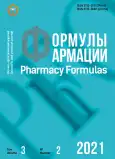Tumor growth – a modern view of pathogenesis and pharmacotherapy (lecture)
- 作者: Tyukavin A.I.1, Suchkov S.V.2,3
-
隶属关系:
- Saint Petersburg State Chemical and Pharmaceutical University of the Ministry of Health of the Russian Federation
- I.M. Sechenov First Moscow State Medical University of the Ministry of Health of the Russian Federation (Sechenov University)
- A.I. Yevdokimov Moscow State University of Medicine and Dentistry
- 期: 卷 3, 编号 2 (2021)
- 页面: 86-96
- 栏目: Actual problems: discussion tribune
- URL: https://journals.rcsi.science/PharmForm/article/view/65284
- DOI: https://doi.org/10.17816/phf65284
- ID: 65284
如何引用文章
全文:
详细
The lecture presents up-to-date information on the prevalence of cancer in the world and in the Russian Federation. The main risk factors and causes of malignant tumors are considered. Particular attention is paid to the mechanisms of transformation of normal cells into tumor cells, and the role of oncogenes and anti-oncogenes in the initiation of malignant growth is shown. Based on modern information about carcinogenesis, the pathogenetic significance of the molecular mechanisms of malignant cell growth at various stages (initiation, promotion, progression) of the tumor process is shown. The mechanisms of evasion of tumors from the influence of immune and other mechanisms that restrain their emergence and development in the body are described, and it is also shown how the spread (metastasis) of malignant cells occurs. The modern tumor markers are presented, on the basis of which the earlier detection of malignant diseases is performed. Particular attention is paid to molecular diagnostic approaches to assessing the risk of occurrence and early diagnosis of malignant neoplasms. Genomic, epigenetic and interactomic tumor markers, which are used in leading domestic and foreign oncological centers, are considered. The most promising approaches to the creation of effective anticancer drugs obtained on the basis of the achievements of molecular biology and bioinformatics are highlighted.
作者简介
Alexander Tyukavin
Saint Petersburg State Chemical and Pharmaceutical University of the Ministry of Health of the Russian Federation
Email: alexander.tukavin@pharminnotech.com
SPIN 代码: 8476-5366
Scopus 作者 ID: 6603645369
Researcher ID: V-6699-2017
Doctor of Medicine (MD), Professor, Head of the Departmen to Physiology and Pathology
俄罗斯联邦, Saint PetersburgSergei Suchkov
I.M. Sechenov First Moscow State Medical University of the Ministry of Health of the Russian Federation (Sechenov University); A.I. Yevdokimov Moscow State University of Medicine and Dentistry
编辑信件的主要联系方式.
Email: ssuchkov57@gmail.com
SPIN 代码: 7052-7335
Doctor of Medicine (MD), Professor, Professor of the Department of Pathology of the I.M. Sechenov First Moscow State Medical University of the Ministry of Health of the Russian Federation (Sechenov University), Professor of the Department of Clinical Allergology and Immunology, A.I. Yevdokimov Moscow State University of Medicine and Dentistry
俄罗斯联邦, Moscow; Moscow参考
- Патология: учебник / под редакцией А.И. Тюкавина. – Москва: ИНФРА-М, 2020. – 844 с.
- Основы персонализированной и прецизионной медицины. Учебник для медицинских вузов и факультетов / под редакцией С.В. Сучкова. – Москва: ГЭОТАР-Медиа, 2020. – 624 с.
- Yan W, Xue W, Chen J, et al. Biological Networks for Cancer Candidate Biomarkers Discovery. Cancer Informatics. 2016; 15(S3): 1–7.doi: 10.4137/CIN.S39458.
- Qian T, Zhu S, Hoshida Y. Use of big data in drug development for precision medicine: an update. Expert Rev. Precis. Med. Drug Dev. 2019; 4(3): 189–200. doi: 10.1080/23808993.2019.1617632.
补充文件

















